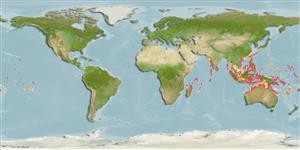>
Eupercaria/misc (Various families in series Eupercaria) >
Labridae (Wrasses) > Cheilininae
Etymology: Cirrhilabrus: Latin, cirrus = curl fringe + Greek, labros = furious (Ref. 45335).
More on author: Smith.
Environment: milieu / climate zone / profondeur / distribution range
Écologie
marin récifal; profondeur 6 - 40 m (Ref. 48636), usually ? - 10 m (Ref. 5278). Tropical; 33°N - 24°S
Indo-Pacific: East Africa south to Sodwana Bay, South Africa (Ref. 4392) and east to the Tuamoto Islands.
Taille / Poids / Âge
Maturité: Lm ? range ? - ? cm
Max length : 12.0 cm SL mâle / non sexé; (Ref. 9823)
Description synthétique
Clés d'identification | Morphologie | Morphométrie
Épines dorsales (Total) : 11; Rayons mous dorsaux (Total) : 8 - 9; Épines anales: 3; Rayons mous anaux: 9. Large oval black spot on caudal peduncle just above lateral line (Ref. 4392). A closely related undescribed species occurs in west and central Pacific; differs in color, greatest between nuptial males (Ref. 48636).
Body shape (shape guide): fusiform / normal; Cross section: compressed.
Occurs over rubble or low patch reefs in areas of current (Ref. 9823); also on reef edges and around bommies with rubble zones (Ref. 48636); often in moderately large groups and mixed sex during feeding on zooplankton well above the substrate. Males often display to each other (Ref. 48636). Reported to be associated with the mushroom coral Heliofungia actiniformis (Ref. 91291). Feeds on zooplankton in the water column (Ref. 9823).
Life cycle and mating behavior
Maturité | Reproduction | Frai | Œufs | Fécondité | Larves
Distinct pairing during breeding (Ref. 205).
Randall, J.E., 1992. A review of the labrid fishes of the genus Cirrhilabrus from Japan, Taiwan and the Mariana Islands, with descriptions of two new species. Micronesica 25(1):99-121. (Ref. 5278)
Statut dans la liste rouge de l'IUCN (Ref. 130435: Version 2025-1)
Menace pour l'homme
Harmless
Utilisations par l'homme
Pêcheries: commercial; Aquarium: Commercial
Outils
Articles particuliers
Télécharger en XML
Sources Internet
Estimates based on models
Preferred temperature (Réf.
123201): 26.3 - 29.3, mean 28.5 °C (based on 2345 cells).
Phylogenetic diversity index (Réf.
82804): PD
50 = 0.5000 [Uniqueness, from 0.5 = low to 2.0 = high].
Bayesian length-weight: a=0.01585 (0.00700 - 0.03587), b=2.95 (2.76 - 3.14), in cm total length, based on LWR estimates for this (Sub)family-body shape (Ref.
93245).
Niveau trophique (Réf.
69278): 3.4 ±0.45 se; based on food items.
Résilience (Réf.
120179): Haut, temps minimum de doublement de population inférieur à 15 mois (Preliminary K or Fecundity.).
Fishing Vulnerability (Ref.
59153): Low vulnerability (10 of 100).
🛈
Nutrients (Ref.
124155): Calcium = 99.2 [57.4, 186.1] mg/100g; Iron = 0.867 [0.498, 1.658] mg/100g; Protein = 18.2 [15.3, 20.4] %; Omega3 = 0.162 [0.095, 0.273] g/100g; Selenium = 22.6 [12.7, 44.7] μg/100g; VitaminA = 256 [76, 929] μg/100g; Zinc = 1.75 [1.17, 2.77] mg/100g (wet weight);
